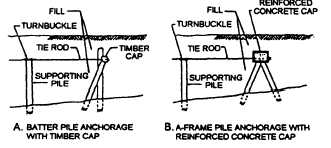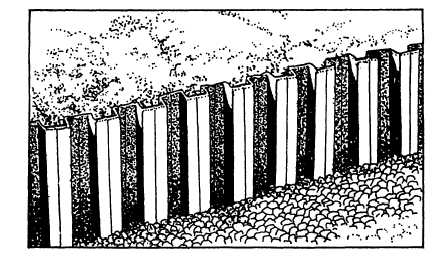1.
2.
3.
4.
Figure 1-17.—Steel sheet-pile bulkhead.
Pile-and-sheathing bulkhead
Wood sheet-pile bulkhead
Steel sheet-pile bulkhead
Concrete sheet-pile bulkhead
Most bulkheads are made of steel sheet piles, such
as shown in figure 1-17, and are supported by a series
of tie wires or tie rods that are run back to a buried
anchorage (or deadman). The outer ends of the tie rods
are anchored to a steel wale that runs horizontally along
the outer or inner face of the bulkhead. The wale is
usually made up of pairs of structural steel channels that
are bolted together back to back.
In stable soil above the groundwater level, the
anchorage for a bulkhead may consist simply of a buried
timber, a concrete deadman, or a row of driven and
buried sheet piles. A more substantial anchorage for
each tie rod is used below the groundwater level. Two
common types of anchorages are shown in figure 1-18.
In view A, the anchorage for each tie rod consists of a
timber cap, supported by a batter pile, which is bolted
to a bearing pile. In view B, the anchorage consists of a
reinforced concrete cap, supported by a pair of batter
piles. As shown in the figure, tie rods are supported by
piles located midway between the anchorage and the
bulkhead.
Bulkheads are constructed from working drawings
like those shown in figure 1-19. The detail plan for the
bulkhead shows that the anchorage consists of a row of
sheet piles to which the inner ends of the tie rods are
anchored by means of a channel wale.
The section view shows that the anchorage will lie
58 feet behind the bulkhead. This view also suggests the
Figure 1-18.—Two types of tie-rod anchorages for bulkheads.
order of construction sequence. First, the shore and
bottom will be excavated to the level of the long, sloping
dotted line. The sheet piles for the bulkhead and
anchorage will then be driven. The intervening dotted
lines, at intervals of 19 feet 4 inches, represent
supporting piles, which will be driven to hold up the tie
rods. The piles will be driven next, and the tie rods then
set in place. The wales will be bolted on, and the tie rods
will be tightened moderately (they are equipped with
turnbuckles for this purpose).
Backfilling to the bulkhead will then begin. The first
backfilling operation will consist of filling over the
anchorage, out to the sloping dotted line. The
turnbuckles on the tie rods will then be set up to bring
the bulkhead plumb. Then the remaining fill, out to the
bulkhead, will be put in. Finally, outside the bulkhead,
the bottom will be dredged to a depth of 30 feet.
To make it possible for ships to come alongside the
bulkhead, it will be fitted with a timber cap and batter
fender piles, as shown in figure 1-20. These piles,
installed at proper intervals, will provide protection
against the impact of ships and will protect the hulls of
ships from undue abrasion.
1-10



